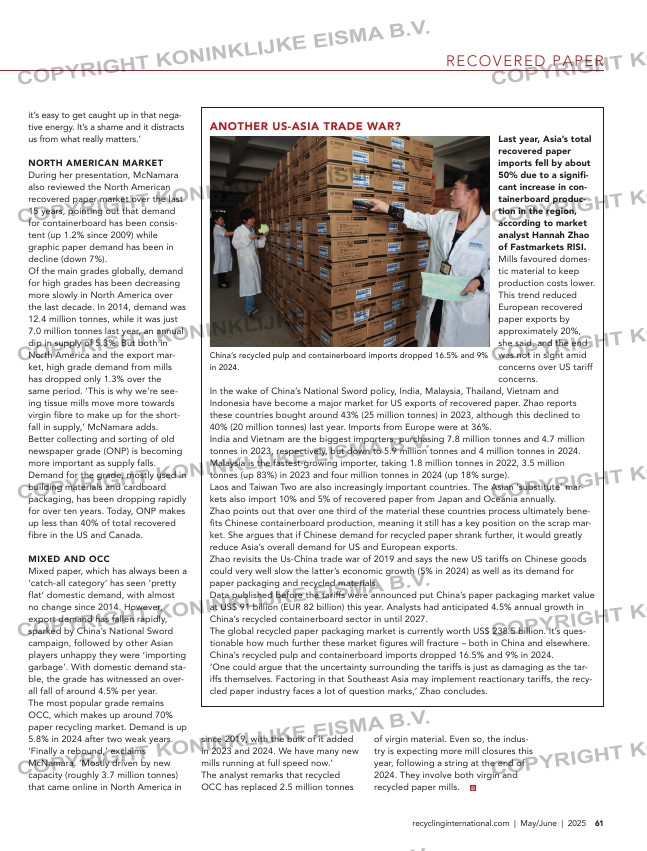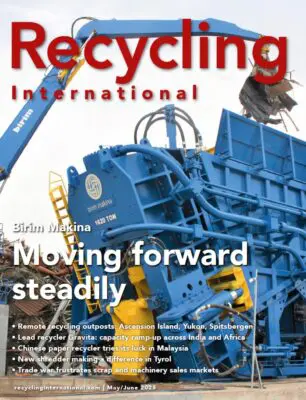Page 61 from: Recycling International May/June issue

61recyclinginternational.com | May/June | 2025
the EU: With net exports of 7.6 mil-
lion tonnes, Europe remains a signifi-
cant supplier. ‘Paper mills rely on
imports because the internal market
collection system cannot meet
demand,’ Hayes observes.
European legislation is increasingly
complicating international trade in
recovered paper, he told delegates.
For example, the new EU Waste
Shipment Regulation, which will apply
from May 2027, will significantly
impede the export of non-hazardous
waste to third countries. The industry
says the law remains unclear, so it has
had to do its own research.
Hayes points out that, thanks to the
European umbrella recycling associa-
tion EuRIC, key importing countries
had completed the necessary regis-
trations with the European
Commission in time. ‘I’m very thankful
to EuRIC that it was able to talk some
sense into EU legislators at the 11th
hour regarding volume quota.’
QUALITY IS KEY
Though the quality of recovered
paper in Germany and other leading
European countries is high, Hayes
says the legal classification of when
paper is waste is an unresolved prob-
lem. ‘Despite years of efforts, there is
no uniform recognition as a product.
Inconsistent regulations across
Europe complicate trade and spark
uncertainty.’
Negotiations on an EU-wide end-of-
waste proposal for paper failed in
March 2025 but the industry is hoping
for progress at national level. ‘As it
stands, recyclers are hitting a lot of
bureaucratic walls.’
At the same time, the quality of
recovered paper is declining due to
economic developments and new
forms of packaging. Fibre-based com-
posite packaging, in particular, com-
plicates recycling and hampers recy-
cling from blue bins.
Hayes concludes that the key to suc-
cess is transparency, shared ambition
and keeping an open dialogue. ‘Every
day we are bombarded with worrisome
headlines about politics. We need to
respect each other, even if we disagree.
The world is getting out of hand and
RECOVERED PAPER
it’s easy to get caught up in that nega-
tive energy. It’s a shame and it distracts
us from what really matters.’
NORTH AMERICAN MARKET
During her presentation, McNamara
also reviewed the North American
recovered paper market over the last
15 years, pointing out that demand
for containerboard has been consis-
tent (up 1.2% since 2009) while
graphic paper demand has been in
decline (down 7%).
Of the main grades globally, demand
for high grades has been decreasing
more slowly in North America over
the last decade. In 2014, demand was
12.4 million tonnes, while it was just
7.0 million tonnes last year, an annual
dip in supply of 5.3%. But both in
North America and the export mar-
ket, high grade demand from mills
has dropped only 1.3% over the
same period. ‘This is why we’re see-
ing tissue mills move more towards
virgin fibre to make up for the short-
fall in supply,’ McNamara adds.
Better collecting and sorting of old
newspaper grade (ONP) is becoming
more important as supply falls.
Demand for the grade, mostly used in
building materials and cardboard
packaging, has been dropping rapidly
for over ten years. Today, ONP makes
up less than 40% of total recovered
fibre in the US and Canada.
MIXED AND OCC
Mixed paper, which has always been a
‘catch-all category’ has seen ‘pretty
flat’ domestic demand, with almost
no change since 2014. However,
export demand has fallen rapidly,
sparked by China’s National Sword
campaign, followed by other Asian
players unhappy they were ‘importing
garbage’. With domestic demand sta-
ble, the grade has witnessed an over-
all fall of around 4.5% per year.
The most popular grade remains
OCC, which makes up around 70%
paper recycling market. Demand is up
5.8% in 2024 after two weak years.
‘Finally a rebound,’ exclaims
McNamara. ‘Mostly driven by new
capacity (roughly 3.7 million tonnes)
that came online in North America in
since 2019, with the bulk of it added
in 2023 and 2024. We have many new
mills running at full speed now.’
The analyst remarks that recycled
OCC has replaced 2.5 million tonnes
of virgin material. Even so, the indus-
try is expecting more mill closures this
year, following a string at the end of
2024. They involve both virgin and
recycled paper mills.
ANOTHER US-ASIA TRADE WAR?
Last year, Asia’s total
recovered paper
imports fell by about
50% due to a signifi-
cant increase in con-
tainerboard produc-
tion in the region,
according to market
analyst Hannah Zhao
of Fastmarkets RISI.
Mills favoured domes-
tic material to keep
production costs lower.
This trend reduced
European recovered
paper exports by
approximately 20%,
she said, and the end
was not in sight amid
concerns over US tariff
concerns.
In the wake of China’s National Sword policy, India, Malaysia, Thailand, Vietnam and
Indonesia have become a major market for US exports of recovered paper. Zhao reports
these countries bought around 43% (25 million tonnes) in 2023, although this declined to
40% (20 million tonnes) last year. Imports from Europe were at 36%.
India and Vietnam are the biggest importers, purchasing 7.8 million tonnes and 4.7 million
tonnes in 2023, respectively, but down to 5.9 million tonnes and 4 million tonnes in 2024.
Malaysia is the fastest-growing importer, taking 1.8 million tonnes in 2022, 3.5 million
tonnes (up 83%) in 2023 and four million tonnes in 2024 (up 18% surge).
Laos and Taiwan Two are also increasingly important countries. The Asian ‘substitute’ mar-
kets also import 10% and 5% of recovered paper from Japan and Oceania annually.
Zhao points out that over one third of the material these countries process ultimately bene-
fits Chinese containerboard production, meaning it still has a key position on the scrap mar-
ket. She argues that if Chinese demand for recycled paper shrank further, it would greatly
reduce Asia’s overall demand for US and European exports.
Zhao revisits the Us-China trade war of 2019 and says the new US tariffs on Chinese goods
could very well slow the latter’s economic growth (5% in 2024) as well as its demand for
paper packaging and recycled materials.
Data published before the tariffs were announced put China’s paper packaging market value
at US$ 91 billion (EUR 82 billion) this year. Analysts had anticipated 4.5% annual growth in
China’s recycled containerboard sector in until 2027.
The global recycled paper packaging market is currently worth US$ 238.5 billion. It’s ques-
tionable how much further these market figures will fracture – both in China and elsewhere.
China’s recycled pulp and containerboard imports dropped 16.5% and 9% in 2024.
‘One could argue that the uncertainty surrounding the tariffs is just as damaging as the tar-
iffs themselves. Factoring in that Southeast Asia may implement reactionary tariffs, the recy-
cled paper industry faces a lot of question marks,’ Zhao concludes.
China’s recycled pulp and containerboard imports dropped 16.5% and 9%
in 2024.
58-59-60-61_altpapiertag.indd 61 10-04-2025 14:22



